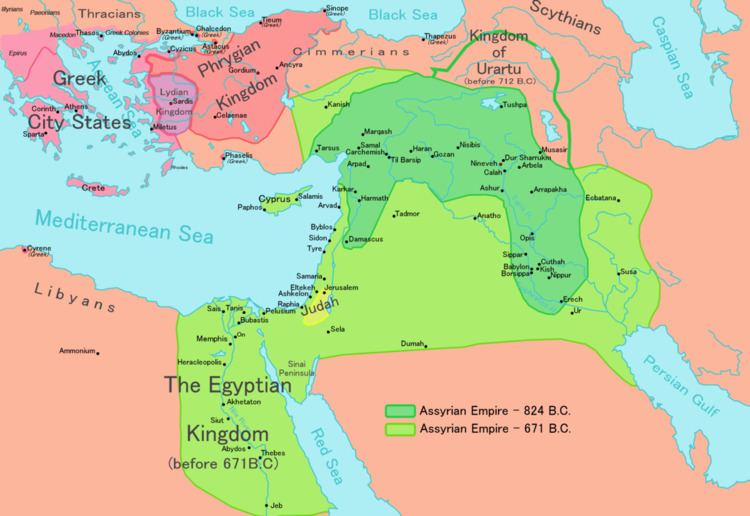 | ||
The list of Assyrian kings is compiled from the Assyrian King List, which begins approximately 2500 BCE and continues to the 8th century BCE. It begins listing Kings of the Sumero-Akkadian city-state of Assur, and later kings of the Assyrian Empires. Assyria is an ancient civilization in northern Mesopotamia (modern northern Iraq, northeastern Syria, and southeastern Turkey). The Assyrian King List includes regnal lengths that appear to have been based on now lost limmu lists (which list the names of eponymous officials for each year). These regnal lengths mostly accord well with Hittite, Babylonian and ancient Egyptian king lists and with the archaeological record, and are generally considered reliable for the age. It is somewhat fictional however, as some known kings are not found on the list and other listed kings are not independently verified.
Contents
- Ctesias
- Castor of Rhodes and Cephalion
- Julius Africanus
- Eusebius of Caesarea
- Excerpta Latina Barbari
- List in Arabic
- References
Prior to the discovery of cuneiform tablets listing ancient Assyrian kings, scholars before the 19th century only had access to two complete Assyrian King Lists, one found in Eusebius of Caesarea's Chronicle (c. 325 AD), of which two editions exist and secondly a list found in the Excerpta Latina Barbari.
An incomplete list of 16 Assyrian kings was also preserved in the literature of Sextus Julius Africanus. Other very fragmentary Assyrian king lists have come down to us written by the Greeks and Romans such as Ctesias of Cnidus (c. 400 BC) and the Roman authors Castor of Rhodes (1st century BC) and Cephalion (1st century AD).
Unlike the cuneiform tablets, the Greek-language list is only considered to contain minor historical truths. Some scholars argue further that they are either entire fabrications or fiction.
Ctesias
Ctesias, as court physician to Artaxerxes II, claimed to have access to the royal historical records. Ctesias' list of Assyrian kings was included in his Persica, a work covering the history of Persia, but the first 3 books were dedicated to pre-Persian Assyria entitled "The History of the Assyrians". How much of Ctesias' king list is factual history is still debated. While most scholars agree large parts are fiction, it is generally agreed that there is historical truth based on the probability his list was rooted in transmitted oral tradition. Classical scholar Robert Drews, however, has argued that Ctesias' list contains information from Babylonian tablets. Although Ctesias's entire work is lost, fragments of it are found preserved in Diodorus Siculus, Nicolaus of Damascus and Photius. From these fragments it is known Ctesias dated the founding of the Assyria to c. 2166 BC, by King Ninus, husband of Queen Semiramis, and 30 further Assyrian kings followed for 1300 years in succession to Sardanapalus (c. 866 BC). Ctesias' list of 30 successors from Ninus (and Semiramis) to Sardanapalus is lost.
Castor of Rhodes and Cephalion
In the 1st century BC, Castor of Rhodes compiled an Assyrian king list, similar to that of Ctesias'. Fragments only remain in mutilated form, but it is known from these fragments that Castor's Assyrian king list started with Belus, and, like Ctesias', included Ninus, also said to be the husband of Semiramis. However, Ninus equates in Castor's list to the second king, not the first and is said to have ruled for 52 years. Castor further dated Belus to 2123 BC. A fragment from Cephalion names Ninus' successor to be Ninyas, his son.
Julius Africanus
An incomplete list of 16 Assyrian kings is found in Sextus Julius Africanus' Chronographiai (early 3rd century AD):
Eusebius of Caesarea
Eusebius of Caesarea's Chronicle (c. 325 AD) contains a complete list of 36 Assyrian kings. Eusebius' King List
Excerpta Latina Barbari
A final list is found in the Excerpta Latina Barbari. The list can be found in Scaliger's Thesaurus temporum (1606). The list dates Belus, the first Assyrian king, to c. 2206 BC.
List in Arabic
The Arab historian al-Ya'qūbī included in his Kitāb al-ta'rīkh written in 873 CE a list of kings of "Mosul and Nineveh" comprising three identifiable Assyrian kings and a queen: Palūs/Tiglath-pileser II (965-936), Ninūs/Tukulti-Ninurta II (890-884), Lāwasnasir/Assurnasirpal II (883-859) and Shamīram/Semiramis (810-806).
According to Arab Scholars (Al Biruni) and reviewed by Sir Issac Newton in The Chronology of Nations
